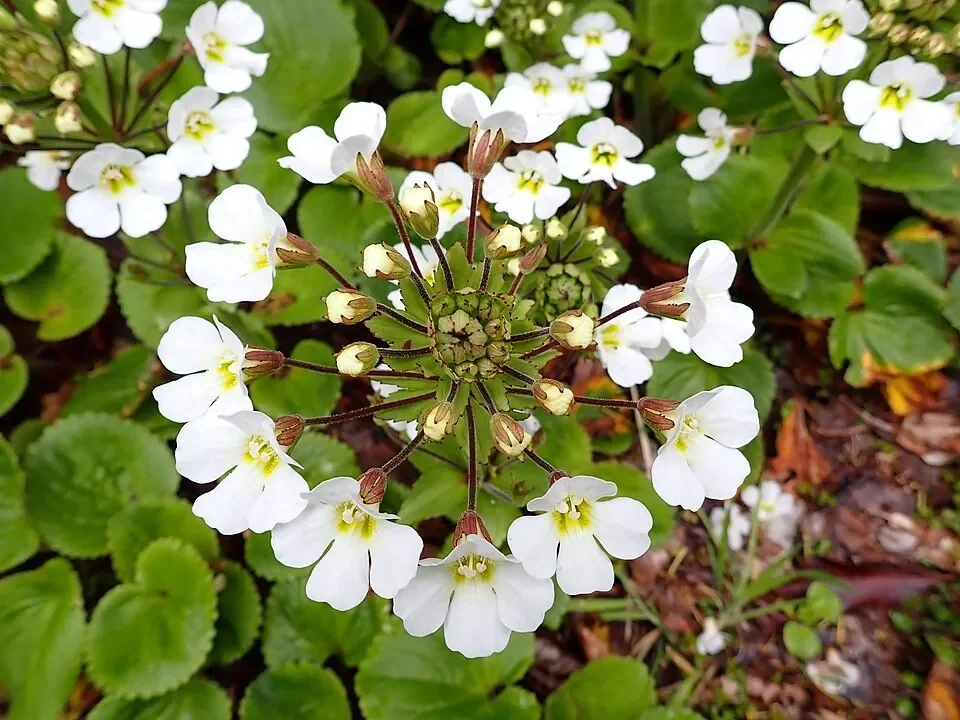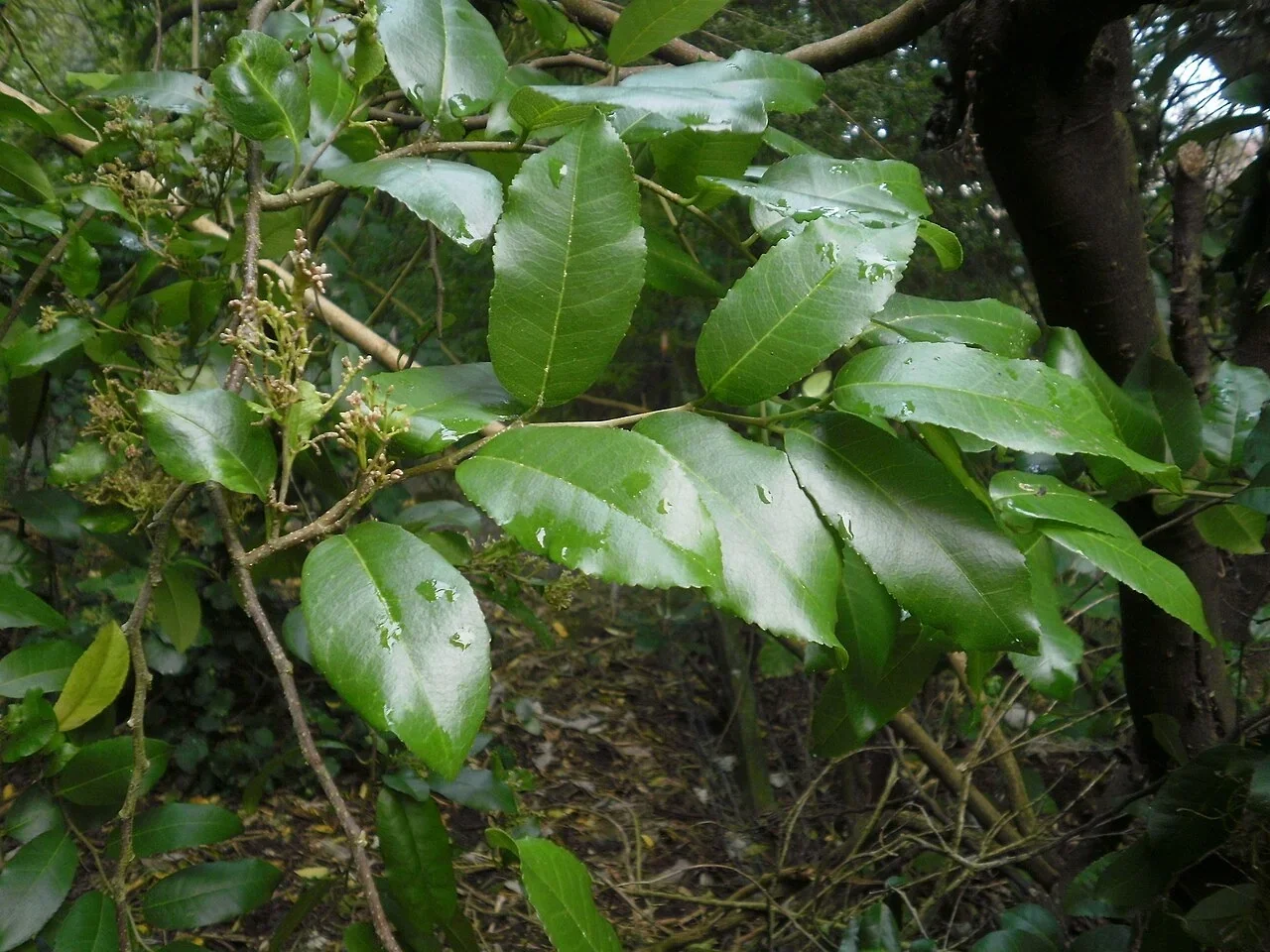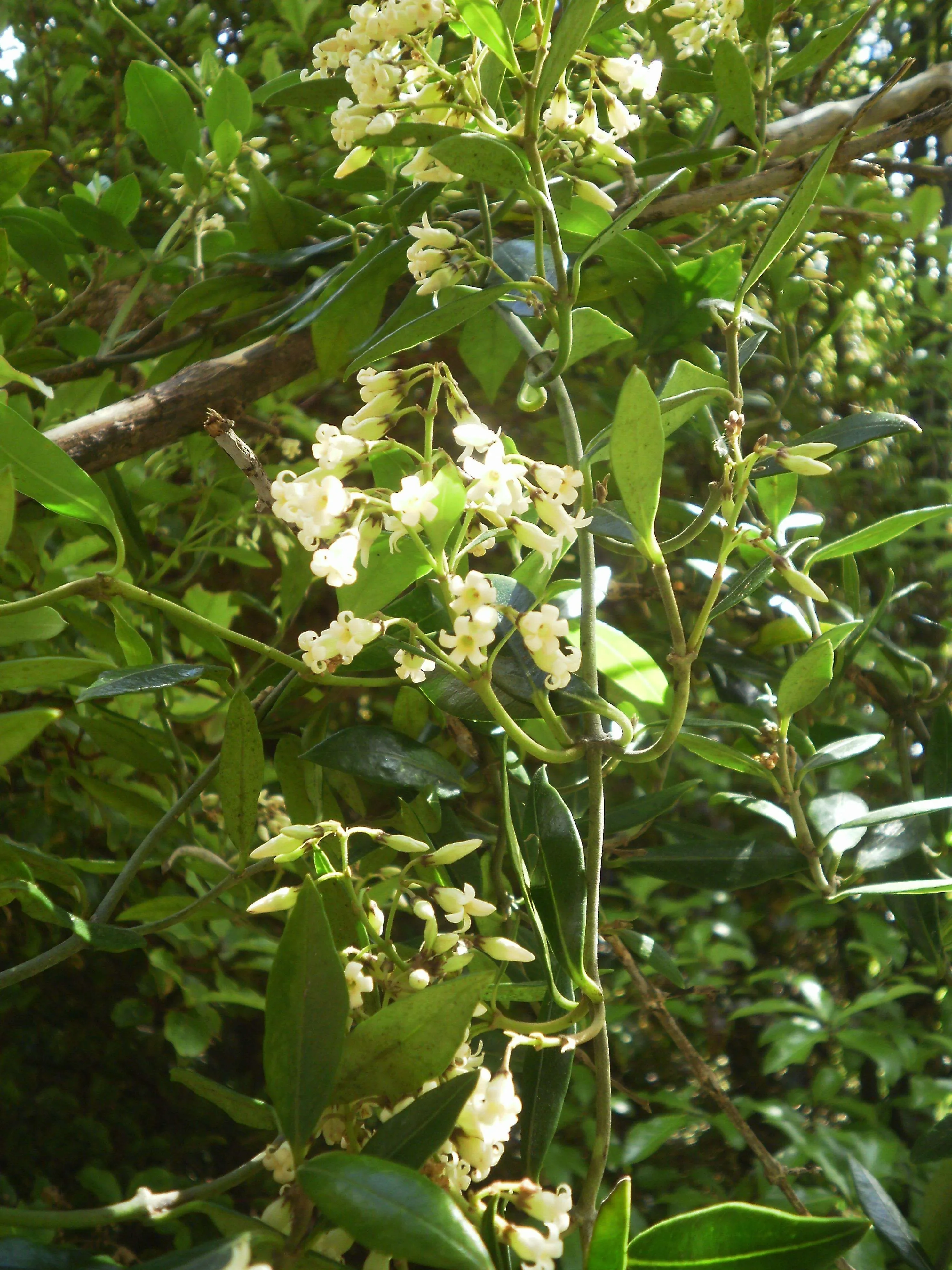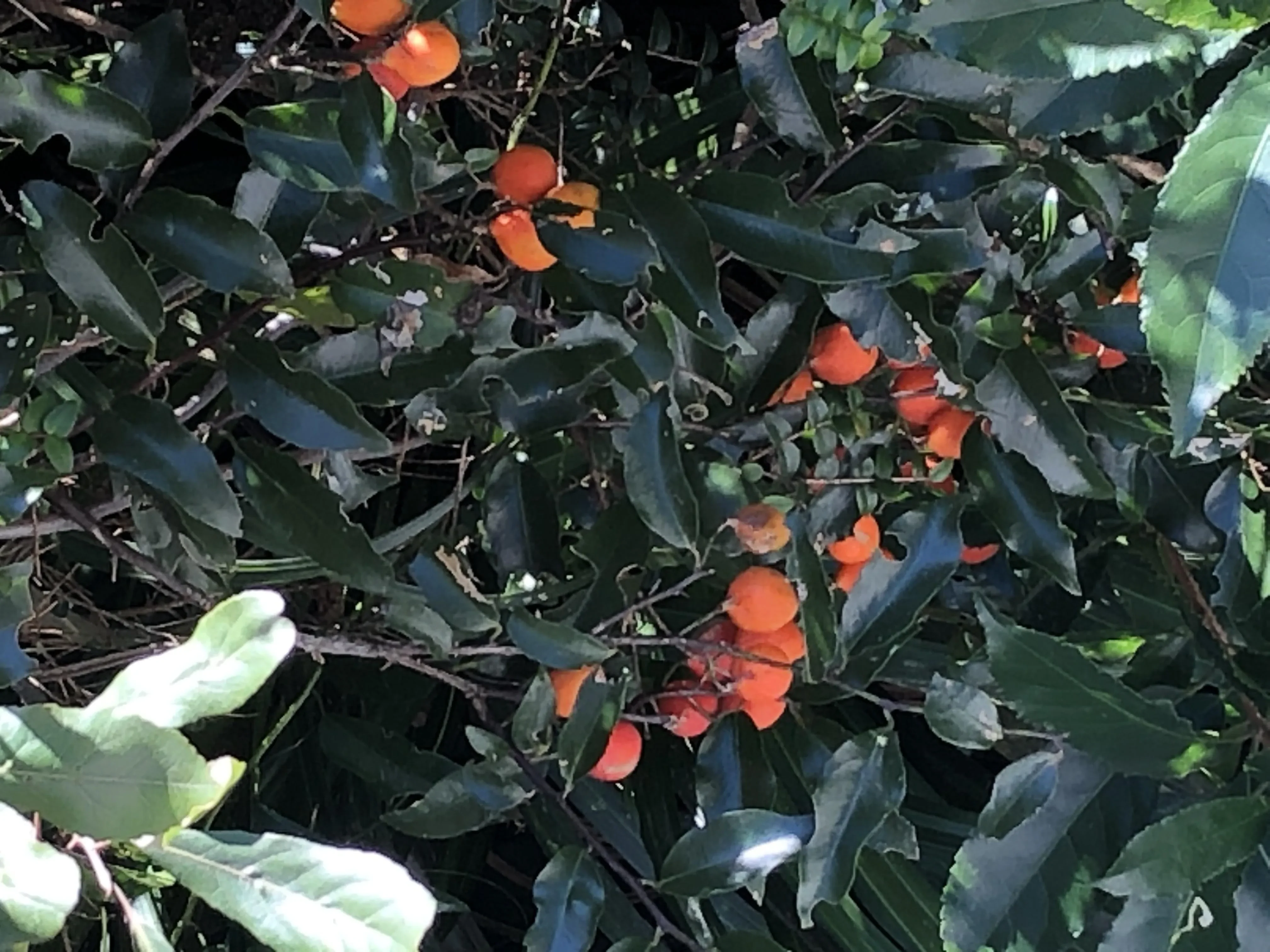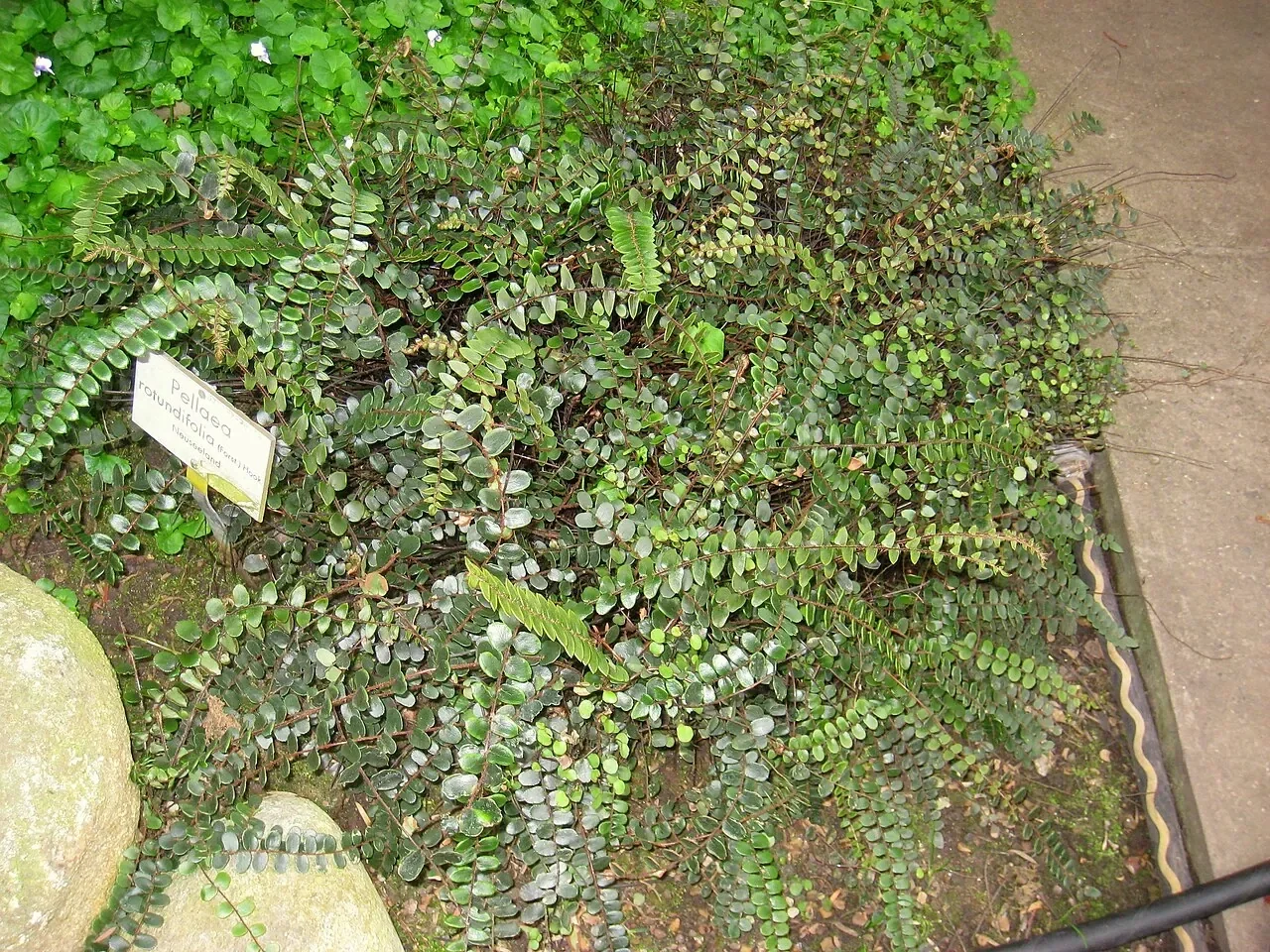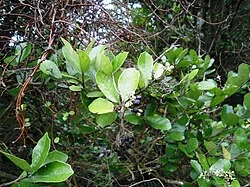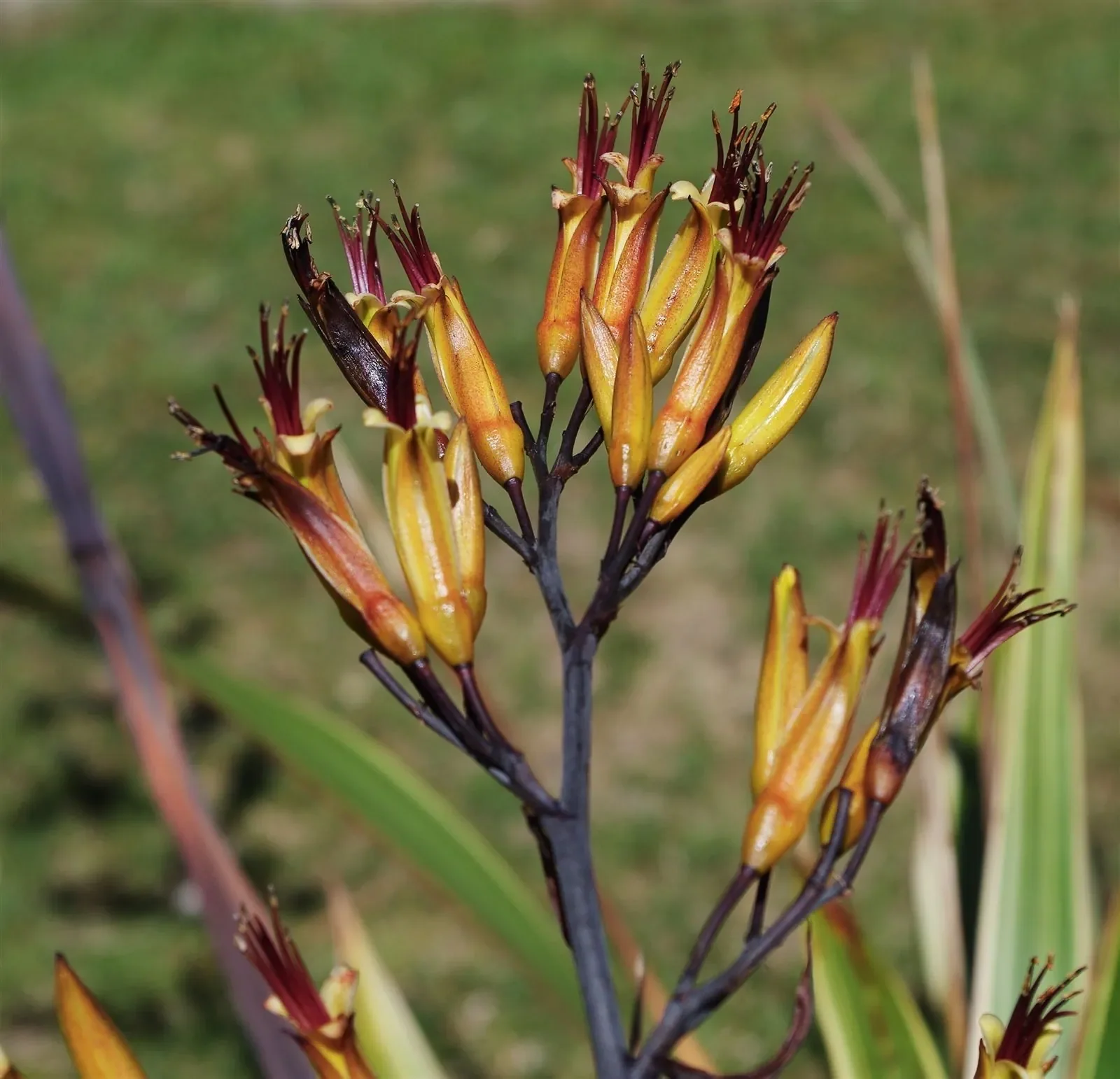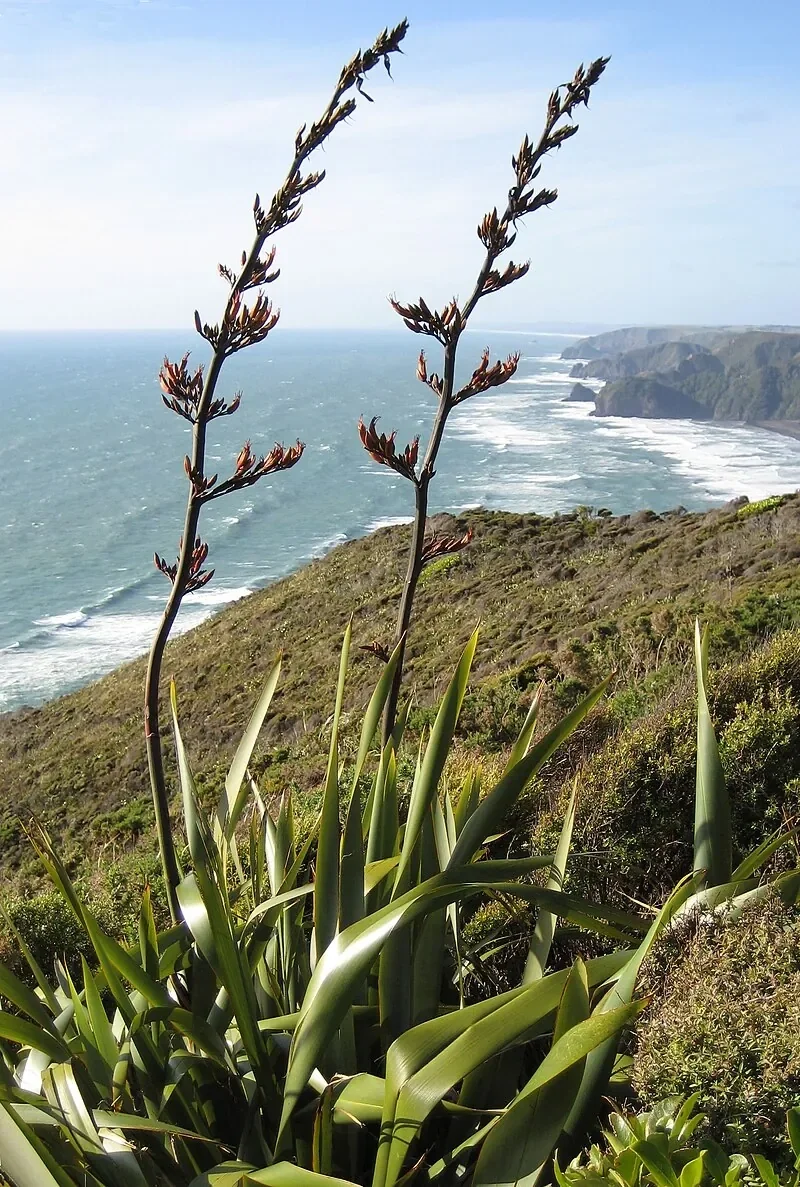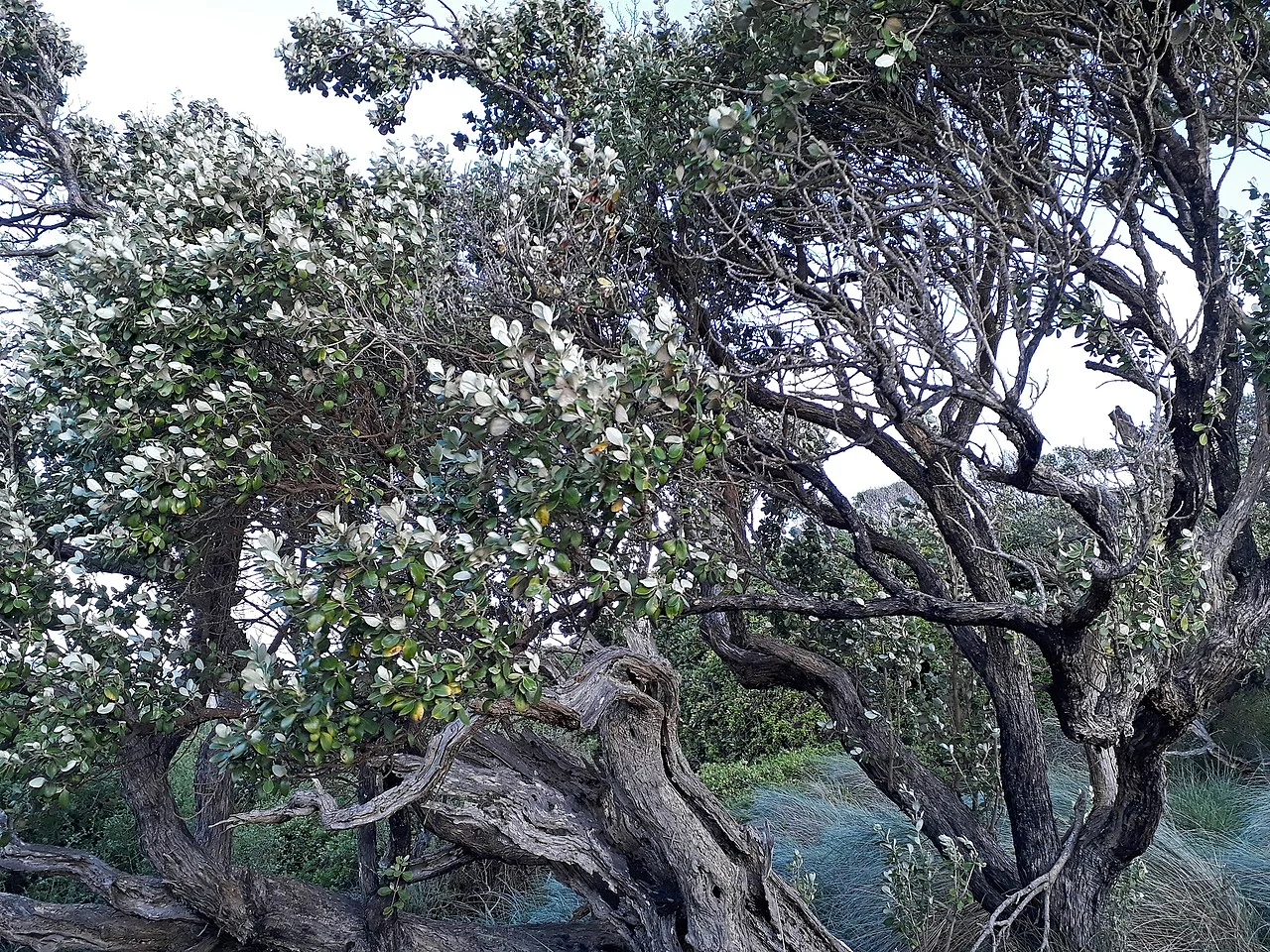
Chatham Island Aster
Olearia traversiorum
Chatham Island Aster (Olearia traversiorum) stands as one of New Zealand's most critically endangered native shrubs, found only on the remote Chatham Islands where it clings to existence in a handful of coastal locations. This remarkable endemic species, classified as Nationally Critical, represents a unique evolutionary branch within the diverse Olearia genus. Distinguished by its distinctive purple daisy-like flowers and silvery foliage adapted to harsh maritime conditions, this rare shrub has captured the attention of conservation botanists worldwide. With fewer than 50 individuals known to exist in the wild, Chatham Island Aster serves as a powerful symbol of the fragility and importance of island endemic flora in native shrub conservation efforts.

Plant Description
Botanical Features
Rēkohu Context and Care
Chatham Island akeake (Olearia traversiorum) is iconic on Rēkohu/Wharekauri, forming stout shelterbelts and durable timber historically valued on the islands. Today, locally sourced planting and pest control safeguard remnant stands from windthrow and browsing. Community nurseries raise stock for farm and road‑edge shelter, retaining the island's distinctive tree daisy character and linking habitat between swamp forest patches and coastal bluffs.
Chatham Island Aster (Olearia traversiorum), also known as Chatham Island akeake, is an evergreen shrub or small tree endemic to the Chatham Islands of New Zealand. It can grow to a height of 12-18 meters, with trunks up to 1 meter in diameter. The bark is light grey, becoming coarsely fibrous, deeply fissured, and rough-textured on older parts of the plant. Its branchlets are quadrangular and stout. The leaves are oval-shaped, ranging from 15-80 mm long and 10-46 mm wide. They are dark green and glossy on the upper surface with a prominent midrib, while the underside is covered in dense, appressed, off-white tomentum (a covering of short, dense hairs). In late spring, it produces small clusters of cream or brownish, daisy-like flowers, sometimes pale yellow. The seeds are fluffy.
Quick Facts
| Scientific Name | Olearia traversiorum |
|---|---|
| Height | 0.5-1.5 m |
| Spread | 1-2 m |
| Water Needs | Moderate, tolerates coastal conditions |
| Light | Full sun to partial shade |
| Frost Tolerance | Moderate, prefers mild conditions |
| Salt Tolerance | High |
| Growth Rate | Slow to medium |
| Lifespan | Medium |
Climate Best Suited to
Chatham Island Aster (Olearia traversiorum) naturally occurs in the unique oceanic climate of the Chatham Islands, characterized by mild temperatures, high humidity, and persistent winds. This species has evolved to thrive in coastal conditions with salt spray tolerance and adaptation to the maritime climate's relatively stable temperatures year-round. The cool, humid conditions with minimal temperature variation make it best suited to coastal areas with mild climates, though it can adapt to slightly inland positions with adequate moisture and protection from extreme heat.
Regional Suitability
| City | Climate Suitability |
|---|---|
| Whangārei | Good |
| Auckland | Ideal |
| Hamilton | Moderate |
| Tauranga | Good |
| Rotorua | Moderate |
| Gisborne | Good |
| New Plymouth | Ideal |
| Napier | Good |
| Whanganui | Good |
| Palmerston North | Moderate |
| Wellington | Ideal |
| Nelson | Good |
| Christchurch | Good |
| Dunedin | Ideal |
| Invercargill | Good |
Natural Habitat
Chatham Island Aster is endemic to the Chatham Islands, an archipelago located southeast of New Zealand. It is commonly found in lowland forests, and is now most prevalent in dune systems. This species also grows along the edges of larger lagoons and lakes, provided the soil is free-draining, and can sometimes be found on cliff tops. It thrives in mild oceanic climates and can tolerate coastal conditions, wind, and partial shade.
Plant Conservation
Olearia traversiorum, also known as Chatham Island akeake or Chatham Island tree daisy, is endemic to the Chatham Islands of New Zealand.
Its conservation status Has Been Classified As:
- Near Threatened (IUCN 2.3)
- Vulnerable (Biota of New Zealand)
- Gevoelig (Dutch for "Sensitive" or "Vulnerable") (IUCN 1998)
Growing Requirements
Soil Requirements
Chatham Island Aster (Olearia traversiorum) requires well-drained soils that mimic the sandy, rocky coastal conditions of its natural habitat. The species cannot tolerate waterlogged conditions but needs consistent moisture availability. Soil should be moderately fertile with good drainage, and the addition of sand or coarse material can improve heavy soils. The species shows tolerance to slightly alkaline conditions reflecting its coastal origins.
- Requires excellent drainage, cannot tolerate waterlogging
- Prefers sandy, well-draining soils similar to coastal conditions
- Tolerates slightly alkaline to neutral pH conditions
- Benefits from organic matter incorporation for moisture retention
- Mulching helps maintain consistent soil moisture levels
Light Requirements
Chatham Island Aster (Olearia traversiorum) performs best in full sun positions but can tolerate partial shade, particularly during the hottest part of the day. In cultivation, some protection from intense afternoon sun can be beneficial, especially in warmer climates than its natural range. Good air circulation is important to prevent fungal issues in humid conditions.
- Prefers full sun for optimal flowering and compact growth
- Can tolerate partial shade, especially afternoon shade
- Requires good air circulation to prevent disease
- Benefits from protection from harsh winds
- Morning sun exposure is particularly important
Water Requirements
Chatham Island Aster (Olearia traversiorum) requires consistent moisture during the growing season but cannot tolerate waterlogged conditions. The species has adapted to the consistent humidity of its maritime environment and benefits from regular watering in cultivation, particularly during dry periods. Reduce watering during winter months when growth slows.
- Requires consistent moisture during growing season
- Cannot tolerate waterlogged or poorly drained conditions
- Benefits from humid conditions and regular misting
- Reduce watering during winter dormancy period
- Mulching helps maintain consistent soil moisture
Planting Guide
1. Growing Conditions:
- Light: Olearia traversiorum thrives in full sun, ideally with at least 6 hours of direct sunlight per day, though it can tolerate partial shade.
- Soil: It prefers well-drained soil and can adapt to various soil types, including sand, loam, and chalk. Good drainage is crucial to prevent root rot, and it does not do well in wet areas. A slightly acidic to neutral pH is generally suitable.
- Moisture: Once established, it is relatively drought-tolerant but benefits from regular watering during its first year. Water deeply but infrequently, allowing the soil to dry out partially between waterings.
- Temperature and Hardiness: It can tolerate light frosts and is hardy in temperatures down to -10 to -5°C (H4 rating in the UK). It prefers moderate temperatures.
- Exposure: It is excellent for exposed, coastal, or windy sites, making it ideal for seaside gardens, windbreaks, or shelter belts.
2. Planting:
- When to Plant: Plant in early spring or early autumn to allow roots to establish before extreme weather.
- Spacing: Space plants 6 to 10 feet apart, depending on whether you intend to use them for hedging or as a specimen tree. Allow room for its natural spread.
- Location: Choose a location with full sun and well-drained soil. It's particularly valued for coastal areas.
Ecological Role
Olearia traversiorum serves as a foundational species in the unique and fragile ecosystems of the Chatham Islands, where it has evolved as an endemic tree that plays crucial ecological roles in both lowland forests and coastal dune systems. This rapidly growing hardy tree represents one of the most important native species supporting the distinctive biodiversity of this isolated archipelago, providing essential habitat structure and resources for the specialized flora and fauna that have evolved in this remote location.
Chatham Islands Forest Ecosystem Foundation
- Lowland forest cornerstone: As a common tree of the original lowland forests, Chatham Island akeake provides essential canopy structure and habitat complexity that supports the unique assemblage of endemic and native species found nowhere else in the world.
- Rapid succession leadership: Fast growth characteristics enable it to quickly colonize disturbed areas and lead forest regeneration processes, creating conditions that allow other native Chatham Islands species to establish and develop sustainable populations.
- Endemic ecosystem support: Provides critical habitat structure for Chatham Islands' endemic birds, including the critically endangered Chatham Island robin and black robin, offering nesting sites and shelter within its robust branching system.
- Soil development facilitation: Large trees reaching 12-18 meters tall with trunks up to 1 meter diameter contribute substantial organic matter through leaf drop and root decay, building and maintaining the soil structure essential for forest ecosystem health.
Dune System Ecological Functions
- Coastal stabilization specialist: Now most commonly found on dune systems, it plays a vital role in binding and stabilizing coastal soils, preventing erosion while creating protected environments that enable other coastal plants to establish and thrive.
- Salt spray tolerance benefits: Natural adaptation to coastal conditions enables it to create protective barriers that filter salt spray and strong winds, establishing microclimates that expand habitat opportunities for less salt-tolerant species.
- Dune succession progression: Facilitates the development of stable dune vegetation communities by providing initial structure and shelter that enables the progression from mobile dunes to established coastal forests over time.
- Marine-terrestrial interface: Creates essential transition zones between marine and terrestrial environments, supporting species that require intermediate conditions and facilitating nutrient exchange between ecosystem types.
Wildlife Habitat and Resource Provision
- Endemic bird sanctuary: Dense foliage and substantial branching structure provide crucial nesting and roosting habitat for Chatham Islands' unique bird species, including support for recovery programs for critically endangered species.
- Pollinator resource center: Late spring cream or brownish flowers in small clusters provide essential nectar resources for the limited pollinator community present on the isolated Chatham Islands, supporting both native and introduced beneficial insects.
- Seed dispersal network: Persistent seed heads attract birds and other fauna, facilitating seed dispersal and genetic exchange within fragmented habitats across the archipelago's varied landscape.
- Invertebrate habitat complexity: Large trees with thick, persistent bark and complex branching create diverse microhabitats for invertebrates, supporting the unique assemblage of endemic and native insects found on the Chatham Islands.
Lagoon and Lake Edge Ecology
- Riparian zone stabilization: Occurs along edges of larger lagoons and lakes in free-draining soils, providing bank stabilization while creating important habitat corridors that connect aquatic and terrestrial ecosystems.
- Water quality protection: Root systems help filter runoff and prevent sedimentation in freshwater systems, maintaining water quality essential for aquatic species including endemic fish and aquatic invertebrates.
- Wetland edge habitat: Creates structural diversity at the interface between aquatic and terrestrial environments, supporting specialized species that require access to both habitat types for different life stages.
- Climate buffering: Provides shade and wind protection for wetland environments, moderating temperature extremes and reducing evaporation that helps maintain stable water levels in lagoons and lakes.
Conservation and Restoration Ecology
- Ecosystem restoration catalyst: Fast growth from both cuttings and seed makes it valuable for active restoration of degraded Chatham Islands habitats, quickly re-establishing forest structure needed for ecosystem recovery.
- Genetic diversity maintenance: As an endemic species, it represents irreplaceable genetic heritage that must be maintained to preserve the evolutionary distinctiveness of Chatham Islands ecosystems.
- Climate resilience provider: Adaptation to the variable conditions of oceanic islands provides important ecosystem stability during climate fluctuations, maintaining habitat structure when other species may struggle.
- Shelter belt functionality: Excellent shelter belt characteristics protect both natural and cultivated areas from the strong winds typical of oceanic environments, creating conditions that support broader biodiversity conservation efforts.
Through its multiple ecological functions, O. traversiorum demonstrates the critical importance of endemic species in maintaining the unique ecosystem integrity of isolated island environments like the Chatham Islands, where every native species plays an irreplaceable role in supporting biodiversity conservation.
Uses and Significance
Conservation Importance
Chatham Island Aster (Olearia traversiorum) represents one of New Zealand's most critical conservation priorities, with its Nationally Critical status reflecting the species' extreme rarity and vulnerability to extinction. Every specimen in cultivation contributes directly to the species' survival, making garden cultivation not just aesthetically valuable but also a vital conservation action. The species serves as a flagship for Chatham Islands conservation and highlights the unique evolutionary heritage of New Zealand's offshore islands.
- Nationally Critical species requiring immediate conservation action
- Fewer than 50 known wild individuals remaining
- Garden cultivation directly contributes to species survival
- Flagship species for Chatham Islands conservation
- Represents unique island evolutionary heritage
Garden Uses
- Exceptional specimen plant for conservation gardens
- Distinctive purple flowers provide seasonal color
- Silvery foliage offers year-round garden interest
- Perfect for coastal gardens and salt-tolerant plantings
- Significant educational value for conservation awareness
Scientific Value
Scientifically, Chatham Island Aster (Olearia traversiorum) provides insights into island biogeography and adaptive evolution in isolated environments. The species represents a unique evolutionary lineage within the Olearia genus and offers opportunities for research into plant adaptation to maritime environments. Its conservation genetics are particularly important for understanding small population dynamics and extinction risk factors.
- Important for island biogeography research
- Unique evolutionary lineage within Olearia genus
- Model species for small population conservation genetics
- Research opportunities in maritime plant adaptation
- Critical for understanding extinction risk factors
As an endemic species of the Chatham Islands, Chatham Island Aster (Olearia traversiorum) holds special significance for local Māoriori and Māori communities as part of their unique island heritage. The species represents the distinctive flora that evolved in isolation and serves as a symbol of the need to protect New Zealand's most vulnerable ecosystems and their cultural connections.
- Part of unique Chatham Islands cultural heritage
- Represents isolated island evolutionary processes
- Symbol of vulnerability and conservation need
- Important for indigenous community connections
- Educational icon for ecosystem protection
Landscaping Ideas
Chatham Island Aster (Olearia traversiorum) offers unique landscaping opportunities as one of New Zealand's most distinctive endemic trees, bringing the rare beauty and resilience of Chatham Islands flora to mainland gardens. This fast-growing, vigorous evergreen combines exceptional wind tolerance with striking visual appeal, making it an outstanding choice for challenging sites where both functional performance and distinctive character are desired.
Coastal and Windbreak Excellence
- Premier coastal windbreak: Exceptional performance in coastal conditions makes it ideal for establishing robust windbreaks that protect entire garden areas from salt-laden winds, creating sheltered microclimates that enable more tender plants to thrive in exposed locations.
- Storm-resistant shelter belts: Vigorous growth to 5 meters tall and 4 meters wide, with potential for larger specimens reaching 12-18 meters, creates substantial protective barriers that withstand extreme weather events while maintaining structural integrity.
- Salt spray tolerance: Natural adaptation to harsh oceanic conditions enables it to flourish where salt spray damages other plants, making it invaluable for beachfront properties and exposed coastal developments.
- Alpine and exposed site solutions: Tolerance for alpine conditions and strong winds extends its usefulness beyond coastal areas to exposed mountain sites, high-altitude gardens, and locations with challenging environmental conditions.
Formal and Structured Landscaping
- Distinctive hedging applications: Responds well to trimming for formal hedge applications, creating dense, neat boundaries with the added visual interest of bright green leaves with distinctive white undersides that flutter attractively in breezes.
- Mixed planting backbone: Serves as an excellent structural foundation in mixed native plantings, providing reliable evergreen framework while its tough, leathery foliage and bright appearance complement other coastal and alpine species.
- Backdrop and screening: Ideal backdrop plant for smaller ornamental species, its light-colored appearance with white undersides and white new stems creates an attractive backdrop that enhances the visibility of foreground plantings.
- Specimen feature plantings: Individual trees create striking focal points with their distinctive bright appearance, oval leaves, and clusters of small white summer flowers that showcase the unique character of Chatham Islands flora.
Conservation and Heritage Landscaping
- Endemic species showcase: Cultivation provides opportunities to display and preserve rare Chatham Islands genetic heritage while educating visitors about New Zealand's unique island biogeography and conservation importance.
- Revegetation projects: Fast growth and hardy nature make it excellent for large-scale revegetation efforts, particularly in challenging coastal and exposed sites where other species struggle to establish.
- Cultural landscape connections: Using the Māoriori name 'hakapiri' acknowledges indigenous cultural connections while supporting conservation efforts for this endemic species and its associated cultural heritage.
- Botanical collection value: Represents an important addition to botanical gardens, arboreta, and collections focused on rare and endangered New Zealand flora, contributing to ex-situ conservation efforts.
Challenging Site Solutions
- Drought and wind tolerance: Exceptional ability to withstand drought and strong winds makes it perfect for exposed sites, hilltops, and areas where irrigation is limited or environmental conditions are severe.
- Soil adaptability: Thrives in chalky, clay, loamy, or sandy soils, growing vigorously in most soil types while tolerating both wet and dry climate conditions with minimal site preparation required.
- Low-maintenance performance: Once established, requires minimal ongoing care while providing maximum landscape impact, making it ideal for extensive landscapes, commercial developments, and low-maintenance garden areas.
- Climate resilience: Hardy to 15°F once established, with natural adaptation to variable oceanic conditions providing excellent performance during climate extremes and changing weather patterns.
Design Integration and Spacing
- Strategic placement recommendations: Position in exposed frontline locations to maximize wind protection benefits, allowing 3-5 meters spacing for hedge applications and 5-8 meters for specimen development to accommodate natural growth potential.
- Layered protection systems: Use as primary windbreak to create protected zones for establishing graduated plant communities, starting with hakapiri barriers and progressing to mid-level shrubs and delicate understory species.
- Seasonal interest maximization: Summer clusters of small white flowers provide seasonal highlights that complement the year-round structural value, while the distinctive white-backed leaves create continuous visual movement and light reflection.
- Companion planting opportunities: Combines well with other hardy natives including Coprosma species, Pittosporum varieties, and coastal grasses to create resilient, diverse plant communities that support wildlife while showcasing New Zealand's unique flora.
Unique Character and Appeal
- Distinctive visual character: Bright overall appearance with green oval leaves featuring white undersides and white new stems creates unique light-reflecting qualities that brighten landscapes and provide visual interest throughout all seasons.
- Rare species value: Offers gardeners the opportunity to grow an authentic piece of Chatham Islands heritage, contributing to conservation while enjoying the distinctive character of this remarkable endemic tree.
- Educational landscape value: Serves as a living example of island evolution and adaptation, providing opportunities for environmental education about New Zealand's unique biogeography and conservation challenges.
- Future landscape investment: As climate change increases the value of resilient, adaptable species, Chatham Island akeake represents a forward-thinking choice that combines beauty, function, and environmental responsibility.
Seasonal Care Calendar
Spring
Spring marks the beginning of active growth for Chatham Island Aster (Olearia traversiorum), with new shoots emerging and flower buds beginning to develop. This is an excellent time for planting new specimens or conducting light pruning. Gradually increase watering as temperatures warm and growth resumes, and apply a balanced, slow-release fertilizer if desired.
- New growth begins with fresh shoots developing
- Apply balanced, slow-release fertilizer if desired
- Ideal time for planting new conservation specimens
- Conduct light pruning before active growth
- Gradually increase watering as growth resumes
Summer
Summer is the peak flowering season for Chatham Island Aster (Olearia traversiorum), with distinctive purple daisy-like flowers appearing from December through February. Maintain consistent moisture during this active growing period and provide protection from extreme heat. This is when the species is most ornamentally valuable and requires close monitoring for conservation purposes.
- Peak flowering period with purple daisy-like blooms
- Maintain consistent watering during dry spells
- Provide protection from extreme heat
- Monitor closely for pest and disease issues
- Excellent time for conservation photography and documentation
Autumn
During autumn, Chatham Island Aster (Olearia traversiorum) completes its flowering cycle and may produce seed if pollination has been successful. This is an excellent time for seed collection for conservation propagation. Begin reducing watering frequency as temperatures cool and growth activity decreases, preparing the plant for its winter rest period.
- Flowering completes and seed development occurs
- Critical time for seed collection for conservation
- Begin reducing watering frequency gradually
- Good time for light structural pruning if needed
- Apply protective mulch before winter
Winter
Winter is a relatively dormant period for Chatham Island Aster (Olearia traversiorum), though the silvery foliage continues to provide garden interest. Significantly reduce watering during this period to prevent root problems. In colder areas, provide protection from frost as this species prefers the mild maritime climate of its native range.
- Dormant period with reduced growth activity
- Significantly reduce watering to prevent root rot
- Provide frost protection in cold-prone areas
- Silvery foliage provides winter garden interest
- Optimal time for major pruning if required
When to Prune and How Much
Chatham Island Aster (Olearia traversiorum) requires minimal pruning to maintain its naturally compact form. Focus on removing dead or damaged growth and light shaping to encourage bushy development. Given the species' conservation status, pruning should be conservative to avoid stressing these valuable plants unnecessarily.
- Remove dead, damaged, or diseased branches any time of year
- Light pruning after flowering to maintain compact shape
- Pinch growing tips when young to encourage branching
- Avoid heavy pruning due to conservation value
- Remove spent flowers to prevent energy drain
- Major pruning best done in late winter if necessary
Always use clean, sharp pruning tools to minimize disease risk and ensure clean cuts. Given the rarity of this species, any pruning material should be carefully considered for propagation opportunities rather than disposal, contributing to conservation efforts.
How to Grow Chatham Island Aster
Chatham Island Aster (Olearia traversiorum) propagation is of critical conservation importance, with every successfully grown plant representing a significant contribution to the species' survival. Due to its extreme rarity, specialized techniques and careful attention to genetic diversity are essential. Both seed and vegetative propagation methods can be successful, though cutting propagation is often more reliable for this challenging species.
From Seed
Growing Chatham Island Aster from seed provides genetic diversity essential for conservation but requires patience and specialized care. Fresh seed offers the best germination potential and should be collected when available from conservation programs.
- Collect ripe seed from conservation sources when available, typically in late summer to early autumn when flower heads have matured and begun to release seeds
- Extract seeds carefully from flower heads and clean thoroughly to remove chaff and debris
- Sow fresh seeds immediately in specialized seed-raising mix with excellent drainage
- Surface sow or barely cover seeds as they may require light for germination
- Maintain consistent moisture using misting rather than direct watering
- Provide bright, indirect light with temperatures around 15-20°C
- Germination may be sporadic and take several weeks to months - patience is essential
- Transplant seedlings very carefully when large enough to handle, usually at 5-8cm height
- Grow on in controlled conditions for at least one full season before considering outdoor planting
Seedlings require especially careful management and should be considered extremely valuable for conservation purposes.
From Semi-Hardwood Cuttings
Semi-hardwood cutting propagation is often the most reliable method for Chatham Island Aster and allows for the preservation of specific genetic lines, making it valuable for conservation purposes.
- Take 8-12cm cuttings from healthy, current season's growth during late summer to early autumn when wood has begun to firm
- Select cutting material from non-flowering shoots for best rooting success
- Remove lower leaves, retaining only 3-4 pairs at the cutting tip
- Make clean cuts just below a node using sharp, sterilized instruments
- Dip cut end in rooting hormone containing IBA to improve success rates
- Insert cuttings into sterile, free-draining propagation mix
- Maintain high humidity using plastic covers or misting systems with temperatures around 18-22°C
- Provide bright, indirect light and maintain consistent moisture
- Root development typically occurs within 6-10 weeks - test by gentle tugging
- Pot up rooted cuttings individually and grow on carefully for conservation value
From Softwood Cuttings
Softwood cuttings taken from new spring growth can also be successful, particularly useful for rapid multiplication of conservation stock during the active growing season.
- Select healthy, soft new growth during early spring to early summer
- Take 6-10cm cuttings early morning when tissues are fully hydrated
- Remove lower leaves and treat with rooting hormone
- Insert into fine propagation medium and maintain very high humidity
- Provide gentle bottom heat and protection from direct sunlight
- Expect rooting within 4-8 weeks under optimal conditions
Conservation Considerations
Due to the critical conservation status of Chatham Island Aster, all propagation efforts should be coordinated with conservation organizations and botanical institutions to ensure genetic diversity is maintained and conservation goals are met.
- Maintain detailed records of all propagation attempts and success rates
- Coordinate with conservation programs to ensure genetic diversity
- Consider tissue culture techniques for mass propagation
- Preserve genetic material through cryogenic storage when possible
- Share propagation successes with conservation networks
Establishment and Conservation Planting
Successful establishment of Chatham Island Aster requires exceptional care and attention to detail, given the conservation value of every individual plant.
- Choose planting sites that closely mimic natural coastal conditions
- Prepare soil carefully to ensure excellent drainage while maintaining moisture
- Plant at the same depth as in containers, avoiding root disturbance
- Provide protection from extreme weather during establishment
- Monitor closely and maintain detailed growth records
- Protect from browsing animals and mechanical damage
- Consider each plant's long-term conservation contribution
With proper care and conservation-focused management, Chatham Island Aster can establish successfully in cultivation, representing hope for this critically endangered species and contributing to its long-term survival for future generations.
Pests and Diseases
Chatham Island Aster (Olearia traversiorum) exhibits exceptional resilience to pests and diseases, a characteristic developed through evolution in the isolated and challenging environment of the Chatham Islands. This hardy endemic species demonstrates remarkable natural resistance that stems from its adaptation to harsh oceanic conditions, making it one of the most reliable and low-maintenance trees for challenging landscape situations.
Natural Disease Resistance
- Endemic species hardiness: Evolution in isolation on the Chatham Islands has resulted in a species with robust natural defenses against most common garden pests and diseases, as island environments typically harbor fewer pathogenic organisms than mainland ecosystems.
- Oceanic adaptation benefits: Natural tolerance for salt spray, strong winds, and variable moisture conditions has created a plant with exceptional stress resistance that rarely experiences the weakness that predisposes plants to pest and disease problems.
- Vigorous growth recovery: Fast growth rate and hardy constitution enable rapid recovery from any minor damage caused by environmental stress or occasional pest activity, maintaining overall plant health and landscape appearance.
- Tough foliage protection: Leathery leaves with waxy protective coatings provide natural barriers against many pest insects while the robust branching structure offers physical resistance to damage from both pests and environmental factors.
Preventive Cultural Practices
- Optimal drainage critical: The most important factor for maintaining healthy Chatham Island aster is ensuring excellent drainage, as waterlogged conditions represent the primary threat to plant health and can predispose plants to root rot in heavy soils.
- Site selection importance: Plant in full sun to partial shade locations with good air circulation, avoiding low-lying areas prone to water accumulation or enclosed spaces that might encourage humidity-related issues.
- Appropriate spacing strategy: Allow adequate spacing between plants (3-5 meters for hedging, 5-8 meters for specimens) to ensure excellent air circulation and prevent overcrowding that could create conditions favorable for pest development or disease spread.
- Soil adaptability advantage: Thrives in most soil types including chalky, clay, loamy, or sandy soils, reducing stress-related vulnerability by adapting to existing conditions rather than requiring specific soil amendments.
Occasional Environmental Challenges
- Wind damage resilience: While generally extremely wind-resistant, severe storm events may cause mechanical branch damage, though the plant's vigorous nature enables rapid recovery with minimal intervention required.
- Transplant establishment: Young plants may experience temporary stress during establishment periods, particularly in very exposed locations, requiring protection and consistent watering until root systems develop fully.
- Extreme cold sensitivity: While hardy to 15°F once established, young plants or those in extremely exposed positions may benefit from protection during severe frost events in marginal climate zones.
- Drought stress symptoms: Prolonged drought conditions may cause temporary leaf browning or growth slowdown, though established plants typically recover quickly once normal moisture returns.
Rare Potential Issues
- Scale insects occasional occurrence: Very rarely, minor scale insect populations may appear on stems, particularly on plants under stress from poor drainage or extreme conditions. These are easily controlled with horticultural oil if detected early.
- Aphids on soft growth: Occasionally, small aphid populations may appear on new growth during favorable spring conditions, particularly on plants receiving excessive nitrogen fertilization. Monitor and treat with insecticidal soap if necessary.
- Fungal issues in poor drainage: Root rot may occur in consistently waterlogged soils, emphasizing the critical importance of proper site selection and drainage for long-term plant health and vigor.
- Sunscald in extreme exposure: Very young plants in extremely exposed locations may experience leaf scorch during establishment, requiring temporary shade protection until canopy development provides self-protection.
Integrated Management Approach
- Preventive site preparation: Focus on proper site selection with adequate drainage and appropriate exposure levels rather than reactive pest and disease management, as prevention is far more effective than treatment.
- Regular monitoring routine: Check plants during routine garden maintenance for signs of stress or establishment issues, particularly during the first few years after planting when plants are most vulnerable.
- Organic intervention methods: If minor pest issues occur, use organic control methods including insecticidal soap, neem oil, or horticultural oils that won't harm beneficial insects or compromise the plant's natural ecosystem functions.
- Water management strategy: Maintain appropriate watering during establishment while avoiding overwatering that can weaken natural defenses and create conditions favorable for root problems.
Environmental Adaptation Advantages
- Salt spray benefits: Natural tolerance for saline conditions provides some pest deterrent effects, as many common garden pests cannot survive in the slightly saline environment that Chatham Island aster thrives in.
- Wind dispersal advantages: Tolerance for strong winds helps prevent pest buildup by physically disrupting insect populations and maintaining good air circulation that discourages fungal disease development.
- Climate resilience value: Adaptation to variable oceanic conditions provides excellent performance during climate extremes, maintaining plant health and resistance during periods when other species may become stressed and vulnerable.
- Low intervention requirements: Exceptional pest and disease resistance makes it ideal for extensive landscapes, remote locations, and situations where regular maintenance access is limited or challenging.
The outstanding pest and disease resistance of Chatham Island aster, combined with its adaptation to challenging environmental conditions, makes it an exceptional choice for sustainable landscaping where reliability, resilience, and minimal intervention are essential for long-term success.
Cultural Significance
Cultural Importance
Chatham Islands Identity
Chatham Island akeake (hakapiri) symbolises endurance in a wind-swept landscape; its durable timber and use in exposed shelterbelts make it a cultural and practical emblem of the islands.
Olearia traversiorum, also known as Chatham Island akeake or hakapiri, holds significant cultural and ecological importance, particularly for the Chatham Islands and its indigenous Māoriori people. Ecologically, it is a vital native species within the Chatham Island ecosystems, offering shelter and food for local fauna. Culturally, Olearia traversiorum is deeply intertwined with the Māoriori people. The Māoriori name for the tree is 'hakapiri'. The term "akeake," which is also associated with this tree, can mean "forever and ever," reflecting the tough and durable nature of its wood. This resilience has led to the Chatham Island akeake being regarded as a powerful symbol of the Māoriori people's own toughness and enduring spirit, especially in the context of their history, including their commitment to pacifism and their ongoing pursuit of Treaty claims settlement. Historically, the plant was discovered in 1840. Beyond its symbolic value, the wood of Olearia traversiorum has practical uses, including for fence posts and firewood. It is also valued in landscaping for its ability to form effective windbreaks or hedges in coastal regions.
Bonus Tip
Chatham Island aster (Olearia traversiorum) appreciates limey, coastal soils but still needs drainage. A coarse shell or grit mulch around the root zone improves aeration and reflects light onto the silvery leaf undersides for extra sparkle.
